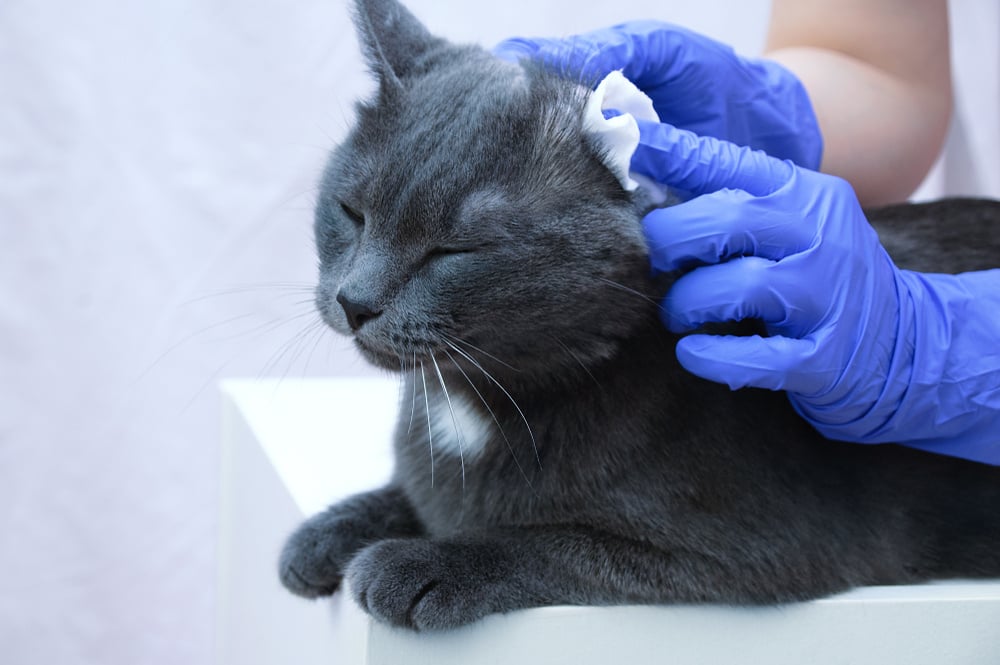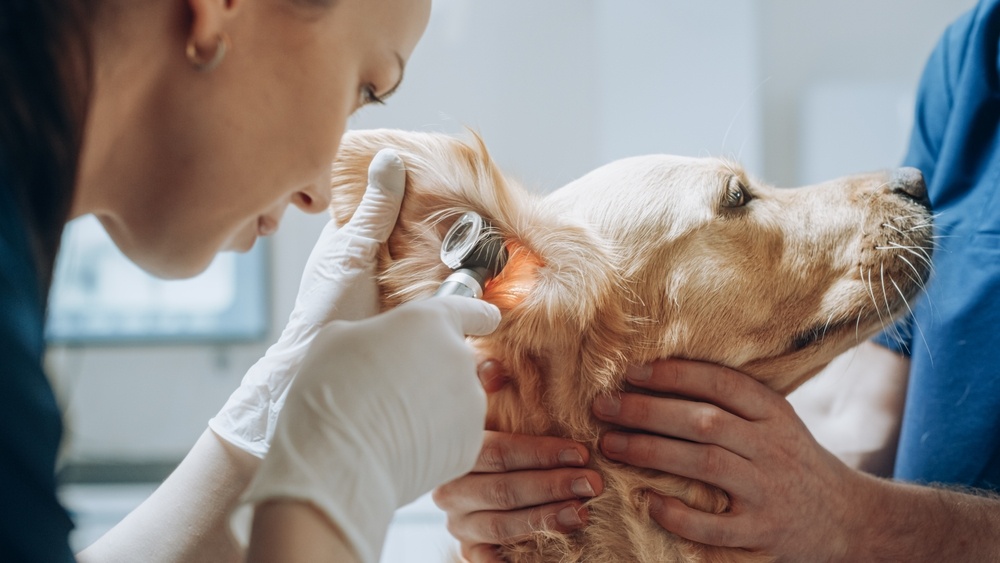The Role of Ear Cleaning in Veterinary Medicine
Regular ear cleaning serves multiple purposes:
- Prevention of Otitis Externa: Routine removal of debris and cerumen reduces the risk of microbial overgrowth.
- Enhancement of Therapeutic Efficacy: Cleaning facilitates better penetration of topical medications.
- Early Detection of Pathologies: Regular examinations allow for the prompt identification of abnormalities.
Best Practices for Ear Cleaning
- Assessment: Conduct a thorough otoscopic examination to evaluate the ear canal and tympanic membrane before cleaning.
- Product Selection: Choose an ear cleaner based on the specific needs of the patient, considering factors such as microbial involvement, inflammation, and cerumen accumulation.
- Frequency: Determine cleaning frequency based on the individual patient's condition, ranging from routine maintenance to more frequent cleaning during active infections.
When to Recommend Ear Cleaning to Pet Owners
Veterinarians should educate pet owners on when and how to clean their pet’s ears properly:
- Routine maintenance – For breeds prone to ear wax buildup or chronic otitis.
- Post-treatment care – Following ear infections to prevent recurrence.
- Before administering medications – Cleaning removes debris and improves drug absorption.
- Preventative care – For dogs that swim frequently or have environmental allergies.
Why select Chlorhexidine-Based Ear Cleaners
Chlorhexidine is a broad-spectrum antimicrobial agent effective against bacteria and fungi. Its cationic nature allows it to bind to negatively charged microbial cell walls, disrupting membrane integrity and leading to cell death. Several studies have demonstrated its efficacy in managing otitis externa.
By effectively managing bacterial and yeast infections at an early stage, chlorhexidine-based solutions reduce reliance on antibiotics, helping to prevent the emergence of multi-drug resistant (MDR) bacteria.
- Broad-Spectrum Antimicrobial Action – Effective against Staphylococcus spp., Pseudomonas spp., and Malassezia pachydermatis.
- Reduces Antibiotic Dependence – By controlling infections topically, it helps minimize the need for oral or injectable antibiotics, slowing antimicrobial resistance development.
- Proven Biofilm Disruption – When combined with Tris-EDTA, it breaks down bacterial biofilms, allowing better penetration of treatments and reducing persistent infections.
- Long-Lasting Effect – Offers residual antimicrobial activity, preventing bacterial and yeast regrowth and reducing recurrence.
- Safe for Regular Use – Formulated at veterinary-approved concentrations (0.2%–0.5%) to avoid ototoxicity and irritation.
When to use Chlorhexidine-Based Ear Cleaners?
1. Bacterial Otitis Externa
- Indication: Cytology reveals bacteria (e.g., cocci or rods) in cases of otitis externa.
- Common pathogens: Pseudomonas aeruginosa, Staphylococcus pseudintermedius.
- Goal: Reduce bacterial load to prevent or decrease the need for antibiotics while also enhancing the effectiveness of treatments through proper cleaning
2. Yeast (Malassezia) Otitis
- Indication: Cytology shows yeast overgrowth (Malassezia pachydermatis).
- Common in: Allergy-prone dogs
- Goal: Reduce yeast load to prevent or decrease the need for antifungal medication while also enhancing the effectiveness of treatments through proper cleaning
3. Recurrent or Chronic Otitis Cases
- Indication: History of recurrent ear infections where prolonged antibiotic use increases the risk of antimicrobial resistance.
- Common pathogens: Multi-drug resistant (MDR) bacteria, biofilm-producing bacteria.
- Goal: Prevent recurrence, manage low-grade infections topically, and reduce antibiotic reliance.
Pre-Treatment Before Otic Medications
4. Pre-Treatment Before Otic Medications
- Indication: To prepare the ear canal before applying topical antibiotics, antifungals, or anti-inflammatory drugs.
- Goal: Enhance drug penetration by removing wax, biofilm, and infectious debris.
Reducing Antibiotic Resistance Through Proper Ear Cleaning
One of the biggest challenges in veterinary medicine is the rise of antibiotic-resistant bacteria, particularly MDR Staphylococcus pseudintermedius and Pseudomonas aeruginosa. Topical chlorhexidine-based ear cleaners help combat this issue by:
- Reducing the bacterial load in the ear before infections become severe.
- Preventing the need for systemic antibiotics, especially in recurrent otitis cases.
- Targeting biofilms, which are a major cause of antibiotic treatment failure.
- Providing long-term maintenance to minimize future infections.
Product selection for Ear cleaning
Effective ear cleaning requires products that efficiently remove debris and excess cerumen, utilizing surfactants to break down wax buildup while reducing bacterial load to help prevent or decrease the need for antibiotics. Proper cleaning also enhances the effectiveness of treatments by ensuring better absorption of active ingredients. Here are the products to keep on hand:
Otodine, a patented ear-cleansing solution combining chlorhexidine and Tris-EDTA, specifically formulated for dogs and cats.
This synergistic combination exhibits potent antibacterial and antifungal properties, effectively managing microbial overgrowth in the ear canal. Chlorhexidine serves as a broad-spectrum antimicrobial agent, while Tris-EDTA enhances its efficacy by disrupting the integrity of bacterial cell walls and biofilms. Studies have demonstrated Otodine's effectiveness against various pathogens associated with canine otitis, including multi-drug resistant strains.
Ghibaudo G, Cornegliani L, Martino PA. Evaluation of the in vivo effects of Tris‐EDTA and chlorhexidine digluconate 0.15% solution in chronic bacterial otitis externa: 11 cases. Vet Dermatol. 2004 Aug;15(s1):65)
Clorexyderm Oto Più, an ear cleanser designed for routine use in dogs and cats. It contains chlorhexidine for antimicrobial action and lactobionic acid, which provides deep moisturizing effects. This formulation ensures effective removal of debris and cerumen, maintaining ear hygiene and preventing conditions conducive to infections. Its non-oily and non-irritating properties make it suitable for regular use, especially in breeds predisposed to otic issues.
Peptivet, available in drops and gel, is an innovative ear solution that combines chlorhexidine, Tris-EDTA, and a novel antimicrobial peptide (AMP2041). This formulation offers broad-spectrum antimicrobial activity against bacteria and fungi, including resistant strains. The inclusion of Vitamin PP (niacin) and Zinc PCA provides soothing and moisturizing effects, aiding in the restoration of the skin barrier and reducing inflammation.
Tris-NAC, a specialized ear cleanser that combines Tris-EDTA with N-acetylcysteine (NAC). This formulation is particularly effective in disrupting and dissolving biofilms, which are often implicated in chronic and recurrent otic infections. By breaking down these biofilms, Tris-NAC® helps to enhance the penetration and efficacy of antimicrobial agents, facilitating more effective treatment outcomes. Its use is especially beneficial in cases where biofilm-producing bacteria are present, as it aids in reducing microbial load and the potential for antibiotic resistance.

